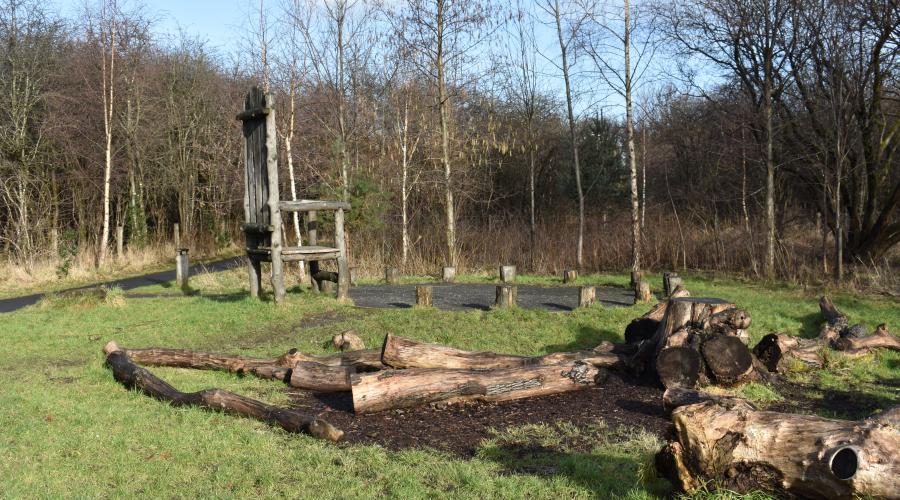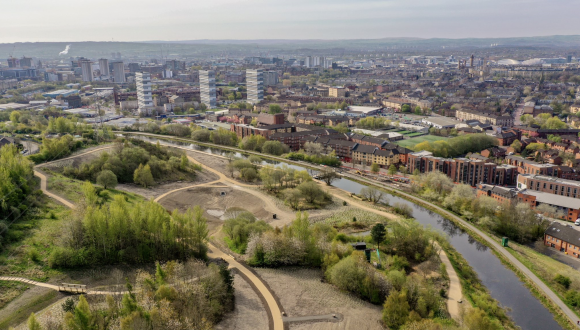
Let's hear it for landscape architects
The role of landscape architects in any successful green infrastructure project is crucial. Working closely with ecologists, engineers and construction teams they ensure that ideas for sustainable and distinctive public spaces come to life. Step forward Claire Stewart and Andrew Redbond, associate landscape architects with Sweco, whose vision, flair and technical know-how helped transform a derelict land fill site in the East End of Glasgow into a stunning urban park.
Claire and Andrew are based in Sweco’s Dennistoun offices and were thus particularly well placed to make a telling contribution to Clyde Gateway’s aspiration to transform Cuningar Loop.
Cuningar Loop, as some of you may know, lies close to Glasgow’ Veledrome and Celtic Park, with the communities of Dalmarnock, Parkhead and Bridgeton all on the doorstep. It’s fair to say these are districts which have faced economic and social challenges. Creating a quality urban green space at Cuningar Loop, which was once a landfill site, was therefore an important project, one which was likely to give the area a huge health and environmental boost.
The site, managed day-to-day by Forestry and Land Scotland, had great potential as an urban park and with an emphasis on woodland creation and making the most of twists and turns in the River Clyde promised to be as interesting as it was beneficial.
Sweco’s Andrew Redbond was certainly excited by the opportunity. “We looked at lots of different ideas for the second phase of the development of this park,” he explained. “There was a desire to have a community focussed building, and we pushed for a raised walkway to allow residents to appreciate the River Clyde better. Practical things like improved access roads and parking, toilets in the community building, along with a range of artistic and exercise features in the park were clearly going to make a big difference too.”
“We completed a feasibility study in 2017, and then Clyde Gateway secured NatureScot’s Green Infrastructure Funding which meant we could move to producing concept designs.
“Sweco had a design team consisting of landscape architects, ecologists, and civil engineers, and we developed our design up to and beyond planning stages. When Robertson Construction won the tender, as they had for the Phase One development of the park, we had a degree of continuity. Both companies have been involved with this project for a good number of years now and know the site intimately.”
Even with that continuity Claire concedes it was a challenging project. “As a former landfill site there were several potentially harmful hazards to negotiate. From discarded building materials and years of accumulated rubbish, to hydrocarbons and asbestos this was a heavily contaminated site and we had to work carefully to ensure we protected the public. We had to consider how would cap the site, and how we would work around an old mine-shaft at one end of the area. It was anything but a straightforward site to develop.”
It is one thing to know what you want to do in a project of this scale, but it’s equally important to ensure your ideas are sympathetic to the site and worked up in partnership with the community.
“We spent a lot of time looking at the existing trees,” explained Andrew. “Claire and I would look at the structure of the woods, walk the site repeatedly, examine aerial photography records, and talk with tree experts to see how we could make best use of existing plants and glades whilst adding new elements. The glades were an important consideration as they allow light into woodlands which in turn encourages a variety of invertebrates and birds. All of this, of course, makes any site more attractive to people.”
“It transpired that there is quite a lot of veteran goat willow on site, which is unusual in an urban setting like this one. Given how unusual this is we needed to select which areas were worth keeping and working with, and which areas we could lose and start afresh. Protecting badgers on the site was another important ecological consideration. Other species weren’t so welcome – the presence of Japanese knotweed and Himalayan balsam were issues we had to tackle. At the end of the day we were trying to get a palate of diverse trees and be careful to only source new species which would cope with the contamination issues here.
Claire shares Andrew’s enthusiasm for the park, and has developed an attachment to the site. “It will be nice to come back over the years and see how Cuningar Loop develops. The trees in Phase Two are obviously still very small, however, if you study the trees planted as part of Phase One back in 2015 you can see that they are well-established. I’m sure that there will be a big difference across the park in five years’ time. This is an aspect of working as a landscape architect which is very rewarding, you genuinely feel that you are making a difference. This has been a particularly rewarding project.”
Where the park goes next is already on Claire’s radar. “Now we want to get more people coming here to use the park. Hopefully the site provides all things they wished for. They can come here and relax or enjoy longer walks. We’ve created longer cycling routes and created a feeling that you are more in nature.
We did a lot of community engagement and got plenty of feedback before we put a single spade in the ground. Two public events allowed us to meet park users, and potential park users, and ask them what they would like to see. It was a nice challenge to take that information and make it work within the confines of the construction restrictions which the site imposed. I like to think we struck a good balance and have helped create something that the public will enjoy for many years.”
So where to next ?
Andrew has a clear vision. “The nice thing about Cuningar Loop from my perspective is that when you get so closely involved with a project for so long you don’t always get the chance to look up and see what you have achieved, you quickly move on to the next project. That hasn’t happened here. We are still involved, and we are looking at further improvements at the likes of the entrance areas. Already there is talk about Phase Three, and a desire to see how much more we can extend the park. That has to be a good thing, and if it gets more land off the derelict and vacant land register I’m sure Glasgow will celebrate.”
When the Phase Two celebrations took place in February, Scotland’s Deputy First Minister John Swinney joined Clyde Gateway, the team from Sweco, Forestry Scotland, the local community, and NatureScot in celebrating success. With any luck there will be a chance to do it all again come Phase Three. In the meantime let’s pause to sing the praises of ambitious landscape architects.






